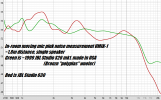ROOSKIE
Major Contributor
For those who have been wondering and waiting.
It appears JBL is getting ready to sell the Studio 6 line in the USA.
It is live on the on the new JBL updated USA site and while one can not yet buy them they are deff presented now.
 www.jbl.com
www.jbl.com
698
 www.jbl.com
www.jbl.com
630
 www.jbl.com
www.jbl.com

It appears JBL is getting ready to sell the Studio 6 line in the USA.
It is live on the on the new JBL updated USA site and while one can not yet buy them they are deff presented now.
Studio 6 Series
The JBL Studio 6 Series brings professional compression driver technology to a more affordable price point. Based upon the 2414H-1 1-inch compression driver mated to a High-Definition Imaging horn, the Studio 6 Series delivers big, dynamics and detailed sound. PolyPlas cone woofers provide...
698
Studio 698 | Home Audio Loudspeaker System
The JBL Studio 698 is a high-performance floorstanding loudspeaker utilizing JBL's 2414H-1 1-inch compression driver mated to a High-Definition Imaging horn complemented with a 6-inch midrange driver and dual 8-inch PolyPlas cone woofers. The elegant cabinet design includes a magnitically...
630
Studio 630 | Home Audio Loudspeaker System
The JBL Studio 630 is a high-performance bookshelf loudspeaker utilizing JBL's 2414H-1 1-inch compression driver mated to a High-Definition Imaging horn complemented with a 6.5-inch PolyPlas cone woofer. The elegant cabinet design includes a magnitically attached grille and brings an element...


![41G30BFAMAL[1].jpg](/forum/data/attachments/205/205784-e46e92f3451382bfd2711eb6a83f9ab6.jpg)